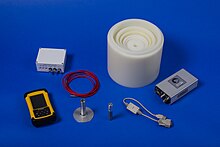Informatics Educational Institutions & Programs
Contents

The nested neutron spectrometer (NNS) is a tool used for neutron spectroscopy. The NNS is used to measure the energy spectrum of neutrons in a neutron field. This type of detector is used in both research facilities (for characterization of neutron fields) and workplaces, where neutron radiation maybe encountered, for radiation protection purposes.[1] Due to the difficulty associated with the detection of neutrons, the NNS is one of the few pieces of equipment capable of accurately determining the characteristics of a neutron field.
Principles of operation
The NNS operates under the same principle as a Bonner sphere neutron spectrometer.[2] The sensitive part of the spectrometer is the Helium-3 proportional counter, which detects neutrons through the reaction 3He(n,p)3H. This particular reaction has a significant cross-section only at thermal neutron energies. In order for a higher energy neutrons to be detected their energies must be decreased, or "moderated". To slow down neutrons at higher energies the NNS uses different amounts of high-density polyethylene (HDPE). The He-3 proportional counter is surrounded by varying amounts of HDPE to sample various energy regions of the neutron field. The standard NNS has seven HDPE cylinders which are nested together, similar to Russian nesting dolls, to measure neutrons of higher and higher energies.



Sample neutron spectra
Shown below are spectra of two standard calibration sources measured by the NNS.[3] The measured spectra (blue) is compared to the ISO standard spectra (red). Both Measurements were made at the NIST low scatter facility in Washington, DC.


References
- ^ J. Atanackovic; W. Matysiak; S. S. Hakmana Witharana; I. Aslam; J. Dubeau & A. J. Wake (September 2012). "Neutron Spectrometry and nd Dosimetry Study at Two Research Nuclear Reactors Using Bonner Sphere Spectrometer (BSS), Rotational Spectrometer (ROSPEC) and Cylindrical Nested Neutron Spectrometer (NNS)". Radiation Protection Dosimetry. 154 (3): 364–374. doi:10.1093/rpd/ncs248. PMID 23019598.
- ^ Dubeau, J.; Hakmana Witharana, S. S.; Atanackovic, J.; Yonkeu, A.; Archambault, J. P. (June 2012). "A neutron spectrometer using nested moderators". Radiation Protection Dosimetry. 150 (2): 217–222. doi:10.1093/rpd/ncr381. ISSN 1742-3406. PMID 21964903.
- ^ Detec (June 10, 2013). "NNS Calibration Results" (PDF). Retrieved July 24, 2013.

















